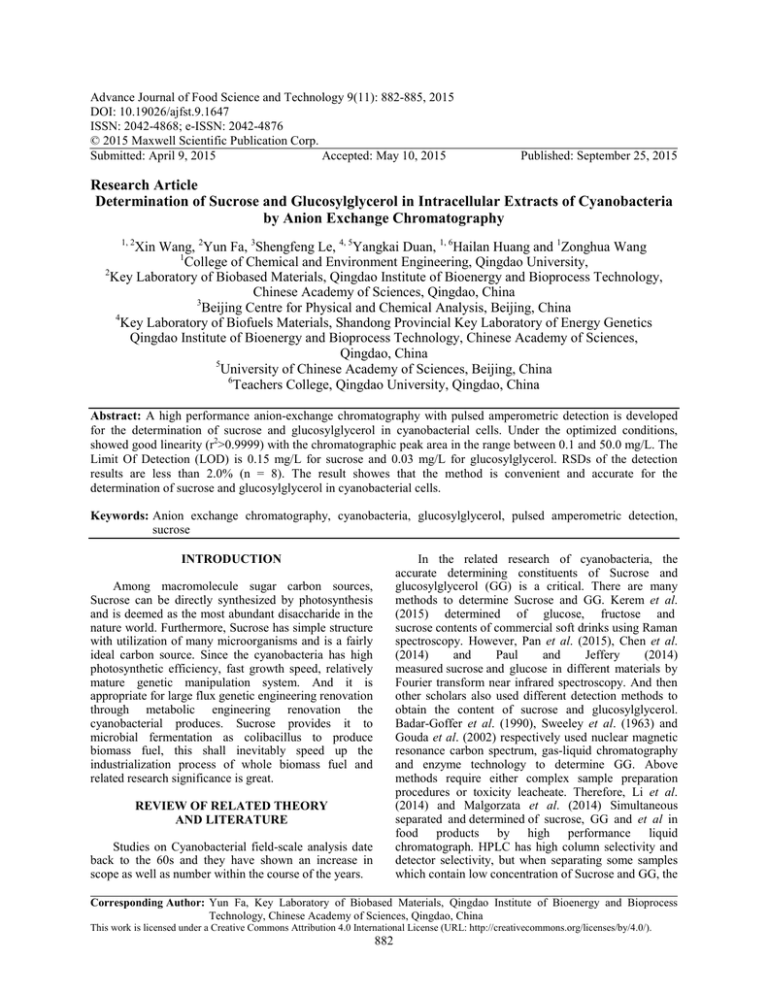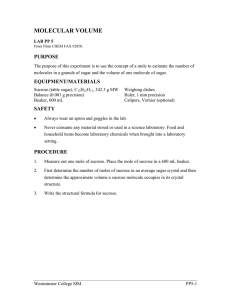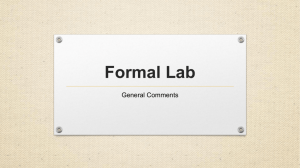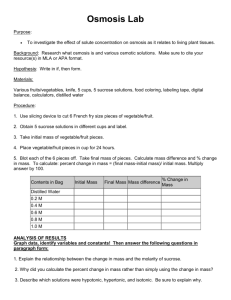Advance Journal of Food Science and Technology 9(11): 882-885, 2015
advertisement

Advance Journal of Food Science and Technology 9(11): 882-885, 2015 DOI: 10.19026/ajfst.9.1647 ISSN: 2042-4868; e-ISSN: 2042-4876 © 2015 Maxwell Scientific Publication Corp. Submitted: April 9, 2015 Accepted: May 10, 2015 Published: September 25, 2015 Research Article Determination of Sucrose and Glucosylglycerol in Intracellular Extracts of Cyanobacteria by Anion Exchange Chromatography 1, 2 Xin Wang, 2Yun Fa, 3Shengfeng Le, 4, 5Yangkai Duan, 1, 6Hailan Huang and 1Zonghua Wang 1 College of Chemical and Environment Engineering, Qingdao University, 2 Key Laboratory of Biobased Materials, Qingdao Institute of Bioenergy and Bioprocess Technology, Chinese Academy of Sciences, Qingdao, China 3 Beijing Centre for Physical and Chemical Analysis, Beijing, China 4 Key Laboratory of Biofuels Materials, Shandong Provincial Key Laboratory of Energy Genetics Qingdao Institute of Bioenergy and Bioprocess Technology, Chinese Academy of Sciences, Qingdao, China 5 University of Chinese Academy of Sciences, Beijing, China 6 Teachers College, Qingdao University, Qingdao, China Abstract: A high performance anion-exchange chromatography with pulsed amperometric detection is developed for the determination of sucrose and glucosylglycerol in cyanobacterial cells. Under the optimized conditions, showed good linearity (r2>0.9999) with the chromatographic peak area in the range between 0.1 and 50.0 mg/L. The Limit Of Detection (LOD) is 0.15 mg/L for sucrose and 0.03 mg/L for glucosylglycerol. RSDs of the detection results are less than 2.0% (n = 8). The result showes that the method is convenient and accurate for the determination of sucrose and glucosylglycerol in cyanobacterial cells. Keywords: Anion exchange chromatography, cyanobacteria, glucosylglycerol, pulsed amperometric detection, sucrose In the related research of cyanobacteria, the accurate determining constituents of Sucrose and glucosylglycerol (GG) is a critical. There are many methods to determine Sucrose and GG. Kerem et al. (2015) determined of glucose, fructose and sucrose contents of commercial soft drinks using Raman spectroscopy. However, Pan et al. (2015), Chen et al. (2014) and Paul and Jeffery (2014) measured sucrose and glucose in different materials by Fourier transform near infrared spectroscopy. And then other scholars also used different detection methods to obtain the content of sucrose and glucosylglycerol. Badar-Goffer et al. (1990), Sweeley et al. (1963) and Gouda et al. (2002) respectively used nuclear magnetic resonance carbon spectrum, gas-liquid chromatography and enzyme technology to determine GG. Above methods require either complex sample preparation procedures or toxicity leacheate. Therefore, Li et al. (2014) and Malgorzata et al. (2014) Simultaneous separated and determined of sucrose, GG and et al in food products by high performance liquid chromatograph. HPLC has high column selectivity and detector selectivity, but when separating some samples which contain low concentration of Sucrose and GG, the INTRODUCTION Among macromolecule sugar carbon sources, Sucrose can be directly synthesized by photosynthesis and is deemed as the most abundant disaccharide in the nature world. Furthermore, Sucrose has simple structure with utilization of many microorganisms and is a fairly ideal carbon source. Since the cyanobacteria has high photosynthetic efficiency, fast growth speed, relatively mature genetic manipulation system. And it is appropriate for large flux genetic engineering renovation through metabolic engineering renovation the cyanobacterial produces. Sucrose provides it to microbial fermentation as colibacillus to produce biomass fuel, this shall inevitably speed up the industrialization process of whole biomass fuel and related research significance is great. REVIEW OF RELATED THEORY AND LITERATURE Studies on Cyanobacterial field-scale analysis date back to the 60s and they have shown an increase in scope as well as number within the course of the years. Corresponding Author: Yun Fa, Key Laboratory of Biobased Materials, Qingdao Institute of Bioenergy and Bioprocess Technology, Chinese Academy of Sciences, Qingdao, China This work is licensed under a Creative Commons Attribution 4.0 International License (URL: http://creativecommons.org/licenses/by/4.0/). 882 Adv. J. Food Sci. Technol., 9(11): 882-885, 2015 Table 1: The detected potential waveform Time/ms 0 200 400 410 420 430 440 500 RPC column or IMPC column is restricted. The chromatographic column of amino-group bonded silica gel and acetonitrile can separate GG and disaccharide fairly well. But it cannot separate some hexose. Therefore, Mou and Li (1995) foung that anion exchange chromatography pulse ampere detection method is very effective to detect sugar and is appropriate for monosaccharide, disaccharide, micromolecule oligosaccharide determination. Meanwhile, Liu et al. (2010), Tang et al. (2007) and Xie et al. (2013) utilized this method respectively to determine sugar in the food and sugar in tobacco and medicine. The writer researches the method of ion chromatography pulse ampere detection method to determine Sucrose and GG in intracellular extracts of cyanobacterial cells. The method has simple preprocessing, good selectivity, high sensitivity and is appropriate for determining Sucrose and GG in intracellular extracts of cyanobacteria. Potential/V(vs. pH) 0.1 0.1 0.1 -2 -2 0.6 -0.1 -0.1 using 3 mL solution, removing protein, pigment and other organic impurities with IC-RP. IC-RP column (1.0 mL, Agela Technologies) should been activated with 5 mL methol and 10 mL ultrapure water, which was used after stewing 20 min. We discarded the former 3 mL solution when the sample passed the column, detecting the later 1 mL solution. Chromatographic condition: IC separation was performed using a capillary column (CarboPac MA1, 0.4 mm×150 mm, Thermo Fisher Scientific) and a guarder (0.4 mm×35 mm, Thermo Fisher Scientific) and integrated pulsed amperometric detection. The flow rate of 800 mL sodium hydroxide solution eluent was 0.4 mL/min at 30°C. The injection volume was 25 µL. The working electrode and reference electrode was respectively gold and Ag/AgCl. The detected potential waveform were shown in Table 1. MATERIALS AND METHODS Instrumentation and materials: An ICS-3000 system (Thermo Scientific Dionex, Sunnyvale, CA, USA) equipped with two pumps, an AS-AP auto-sampler were used in this study. Chromeleon software (Thermo Fisher Scientific, San Jose, California) was used for system control. Sodium hydroxide (50%) was obtained from Acros Organics (Belgium). Sucrose standard was purchased from SigmaAldrich (St. Louis, MO, USA). Glucosylglycerol was purchased from Bitop AG (Stockumer, Germany). All the solutions were prepared in 18.2 MΩ water (Milli-Q) with a 0.22 µm nylon membrane filter. Bicarbonate standard was purchased from SigmaAldrich (St. Louis, MO, USA). RESULTS AND DISCUSSION The choice of chromatographic column: Schoor et al. (1995) suggested When adopting HPLC to separate the sample containing low concentration Sucrose and GG, separation capability of RPC column and IMPC column is restricted. CarboPac PA10 chromatographic column can separate Sucrose and GG. Nevertheless, when detecting actual sample, the stutter peak is coincided with chromatographic peak of Sucrose and this disturbs detection of Sucrose. The separation effect of CarboPac MA1 is fairly good, when detecting actual sample, Sucrose and other unknown constituents do not have the phenomenon of leaching. The separation of Sucrose and GG standard substance is shown in Fig. 1. Preparation of standard solutions: 0.01 g of Sucrose and Glucosylglycerol were prepared in 10 mL volumetric flasks with ultrapure water respectively used their stock solutions. Nine standards of Sucrose and Glucosylglycerol were prepared respectively by pipetting 1, 5, 10, 20, 50, 100, 200, 500, 1000 µL, respectively of their stock solutions into 10 mL volumetric flasks and diluting to volume with ultrapure water. The concentrations of standard series were both 0.1, 0.5, 1.0, 2.0, 5.0, 10.0, 20.0, 50.0, 100.0 ppm. Selection of elution concentration: The impact of 300, 500, 800, 1000 mmol/L NaOH leacheate to separation effect of Sucrose and GG is respectively investigated and the result shows that, at concentration of 300 mmol/L and 500 mmol/L, Sucrose and GG can be separated, but separation time is fairly long and exceeds 1 h; for leacheate of 800 mmol/L, Sucrose and GG can be separated within 30 min, for leacheate of 1000 mmol/L, separation effect of Sucrose and GG is not ideal. Therefore NaOH of 800 mmol/L is selected as elution. Sample preparation: Cultures were sampled by taking 1.5 mL aliquots for 1 day, 2 days, 3 days, 4 days and 5 days respectively after added 600 mM NaCl that were centrifuged at 6000 r/min for 5 min to obtain cell pellets and supernatants. The supernatants were diluted 10 times and filtered using 0.22 µm water nylon membrane Evaluation of the methods: Progressively dilute Sucrose and GG standard stock solution to respectively 883 Adv. J. Food Sci. Technol., 9(11): 882-885, 2015 Fig. 1: Chromatogram of GG and sucrose; 1-GG; 2-Sucrose Fig. 2: Chromatogram of different culture solutions of GG and sucrose; 1-GG; 2-Sucrose; Sample 1-cultivated 24 h; Sample 2cultivated 48 h; Sample 3-cultivated 72 h; Sample 4-cultivated 96 h; Sample 5-cultivated 120 h derive 0.10, 0.50, 1.00, 2.00, 5.00, 10.00, 20.00, 50.00 mg/L Sucrose and GG standard mixed solution, sample size is 25 µL, the mass concentration of standard substance is of linear regression with related chromatographic peak area to derive linear equation. The linear scope, linear equation, correlation coefficient and detection limit (S/N = 3) data are shown in Table 2. Table 2 shows Sucrose and GG linear correlation coefficient is both 99.99% and detection limit is respectively 0.03 mg/L and 0.15 mg/L. The sample is injected by 8 times via 2 mg/L Sucrose and GG mixed solution, determination result is shown in Table 2. Table 2 shows that relative standard deviation of 8 times’ determination result of Sucrose and GG is respectively 0.755 and 1.694% and it presents that measurement accuracy of this method is fairly high. The blue-green algae culture solution sample is taken and treated as per 1.3 method and determined at 1.4 chromatographic condition, the sample is respectively added by 1.0, 10.0 and 20.0 mg/L Sucrose and GG mixed standard substance and repeatedly tested and the determination result is shown in Table 2. Table 2 shows that, mean standard addition recovery rate of Sucrose and GG is 99.13 and 94.23% and it 884 Adv. J. Food Sci. Technol., 9(11): 882-885, 2015 Table 2: Detection results of GG and sucrose standard stock solution Linearity range Equation of linear Correlation Analyte /(mg/L) regression coefficient r2 (n = 7) Sucrose 0.5-50 Y = 1.5181X-0.1478 0.99998 GG 0.1-50 Y = 1.5616X-0.0432 0.99994 Table 3: Content of different culture solutions of GG and Sucrose mg/L Analyte Sample 1 Sample 2 Sucrose 42.1293 45.9899 GG 14.0667 14.0515 presents that measurement accuracy of this method is fairly high. Detection limit/(mg/L) 0.15 0.03 Sample 3 30.6850 10.3120 RSD/% 0.755 1.694 Sample 4 35.1220 10.0735 Recovery rate /% 99.13 94.23 Sample 5 39.3814 10.1023 Kerem, I., B.I. Hakki and T. Ali, 2015. Rapid analysis of glucose, fructose and sucrose contents of commercial soft drinks using Raman spectroscopy [J]. Food Control, 48: 56-61. Li, Y.Z., S.H. Liu, Z.Y. Zhu and Y.M. Yang, 2014. Determination of glucose, fructose and sucrose in jackfruit by HPLC [J]. Food Sci., 35: 84-87. Liu, X., D. Li, J. Shi and C. Sun, 2010. Determination of monosaccharides and disaccharides in drink by ion chromatography with pulsed amperometric detector [J]. Chinese J. Spectrosc. Lab., 27: 441-445. Malgorzata, G., L. Anna and S. Piotr, 2014. Simultaneous separation and determination of erythritol, xylitol, sorbitol, mannitol, maltitol, fructose, glucose, sucrose and maltose in food products by high performance liquid chromatography coupled to charged aerosol detector [J]. Microchem. J., 117: 77-82. Mou, S. and Z. Li, 1995. The progress of Carbohydrates determination separation with pulsed am perometric by anion exchange dete ctiol [J]. Chinese J. Chromatogr., 13: 320-324. Pan, L., Q. Zhu and R. Lu, 2015. Determination of sucrose content in sugar beet by portable visible and near-infrared spectroscopy [J]. Food Chem., 167: 264-271. Paul, L. and S. Jeffery, 2014. Assessment of crystallinity in processed sucrose by near- infrared spectroscopy and application to lyophiles [J]. J. Pharm. Sci., 103: 2884-2895. Schoor, A., N. Erdmann, U. Effmert and S. Mikkat, 1995. Determination of the cyanobacterial osmolyte glucosylglycerol by high-performance liquid chromatography [J]. J. Chromatogr. A, 704: 89-97. Sweeley, C.C., R. Bentley and M. Makita, 1963. Gasliquid chromatography of trimethylsilyl derivatives of sugars and related substances [J]. J. Am. Chem. Soc., 85: 2497-2484. Tang, K.T., L.N. Liang, Y.Q. Cai and S. Mou, 2007. Determination of sugars and sugar alcohols in tobacco feed liquids by high performance anionexchange and pulsed amperometric Detection [J]. Chinese J. Anal. Chem., 25: 451-452. Xie, Q., Q. Li, K. Wang and C. Liu, 2013. Determination of carbohydrate in honey and juhong pills by HPLC [J]. Chem. Anal. Meter., 1: 45-47. Sample determination: This method is adopted to determine Sucrose and GG of five cyanobacteria cell culture solutions sampled at different time interval. The sample chromatogram is shown in Fig. 2, which means that separation among Sucrose, GG and sample base constituent is good, without disturbance for determination. In the sample, content of Sucrose and GG is shown in Table 3. CONCLUSION Ion chromatography pulse ampere detection method is adopted to determine Sucrose and GG in cyanobacteria, the minimum detection limit is respectively 0.03 mg/L and 0.15 mg/L, which is lower than the minimum detection line (14 mg/L) of Sucrose determination by high performance liquid chromatography evaporation light scattering detection method. The measurement accuracy meets the requirement and can be used to determine Sucrose and GG of intracellular extracts of cyanobacteria at the same time. ACKNOWLEDGMENT This project is supported by the National Science Foundation (Grant NO.21405166) and the National Special Fund for Major Research Instrumentation Development (Grant No. 2012YQ090229). REFERENCES Badar-Goffer, R.S., H.S. Bachelard and P.G. Morris, 1990. Cerebral metabolism of acetate and glucose studied by 13C-nmr spectroscopy: A technique for investigating metabolic compartmentation in the brain [J]. Biochem. J., 266: 133-135. Chen, S.F., M.G. Danao, V. Singh and P.J. Brown, 2014. Determining sucrose and glucose levels in dual-purpose sorghum stalks by Fourier transform near infrared (FT-NIR) spectroscopy [J]. J. Sci. Food Agr., 94(12): 2569-2576. Gouda, M.D., M.A. Kumar and M.S. Thakur, 2002. Enhancement of operational stability of an enzyme biosensor for glucose and sucrose using protein based stabilizing agents [J]. Biosens. Bioelectron., 17(6-7): 503-505. 885





